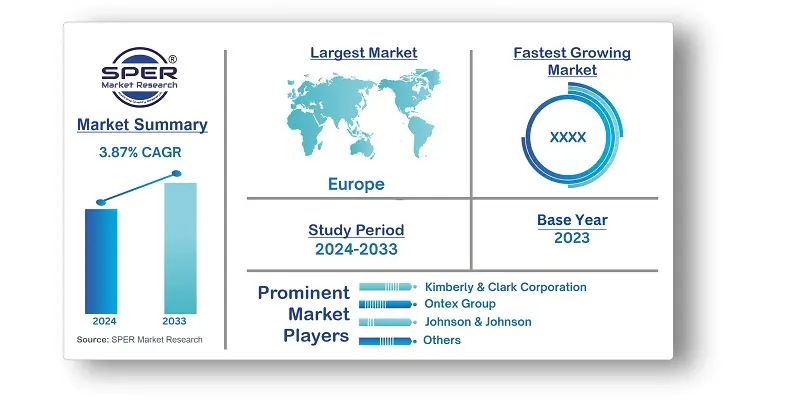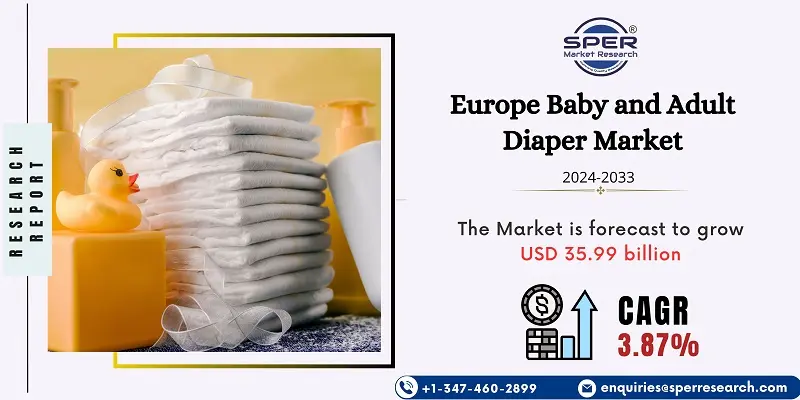
Europe Baby and Adult Diaper Market Trends, Share, Size, Demand, Revenue and Future Outlook
Europe Baby and Adult Diaper Market Growth, Size, Trends Analysis- By Baby Diaper Type, By Adult Diaper Type, By Distribution Channel- Regional Outlook, Competitive Strategies and Segment Forecast to 2033
| Published: Nov-2024 | Report ID: FMCG24207 | Pages: 1 - 159 | Formats*: |
| Category : Consumer & Retail | |||
- In March 2024, the environmentally conscious German hygiene brand Vyld declared that it would launch compostable core diapers made from algae. The project's goal is to turn dirty diapers into a useful resource by using composted diaper waste as humus fertilizer.
- In November 2023, the EU-funded PAWN project unveiled a novel, highly absorbent solution that tackles the environmental issues associated with conventional diapers.


| Report Metric | Details |
| Market size available for years | 2020-2033 |
| Base year considered | 2023 |
| Forecast period | 2024-2033 |
| Segments covered | By Baby Diaper Type, By Adult Diaper Type, By Distribution Channel |
| Regions covered | Germany, United Kingdom, Italy, Spain, France, Russia, Rest of Europe |
| Companies Covered | Procter & Gamble, Kimberly & Clark Corporation, Unicharm Corporation, Domtar Corporation, Ontex Group, Kao Corporation, Hengan International Group company, Johnson & Johnson, Drylock Technologies, Paul Hartmann AG. |
- Disposable diapers are the most popular product kind: The Europe diaper market research includes a complete breakdown and analysis of the industry based on product type (baby diaper). This covers disposable diapers, training diapers, cloth diapers, swim pants, and biodegradable diapers. Disposable diapers were the largest sector.
- The disposable infant diaper industry in Europe is expanding rapidly, owing to the increasing number of dual-income couples in which both parents work. Furthermore, disposable diapers are the preferred choice for these busy households due to their ease and efficiency.
- Parents and caregivers of infants and toddlers
- Elderly individuals and their families
- Care facilities and nursing homes
- Individuals with disabilities and chronic health conditions
- E-commerce retailers and pharmacies
- Healthcare providers and medical institutions
| By Baby Diaper Type: | |
| By Adult Diaper Type: | |
| By Distribution Channel: | |
| By Region: |
- Europe Baby and Adult Diaper Market Size (FY’2024-FY’2033)
- Overview of Europe Baby and Adult Diaper Market
- Segmentation of Europe Baby and Adult Diaper Market By Baby Diaper Type (Disposable Diapers, Training Diapers, Cloth Diapers, Swim Pants, Biodegradable Diapers)
- Segmentation of Europe Baby and Adult Diaper Market By Adult Diaper Type (Pad Type, Flat Type, Pant Type)
- Segmentation of Europe Baby and Adult Diaper Market By Distribution Channel (Supermarkets and Hypermarkets, Pharmacies, Convenience Stores, Online Stores, and Others)
- Statistical Snap of Europe Baby and Adult Diaper Market
- Expansion Analysis of Europe Baby and Adult Diaper Market
- Problems and Obstacles in Europe Baby and Adult Diaper Market
- Competitive Landscape in the Europe Baby and Adult Diaper Market
- Impact of COVID-19 and Demonetization on Europe Baby and Adult Diaper Market
- Details on Current Investment in Europe Baby and Adult Diaper Market
- Competitive Analysis of Europe Baby and Adult Diaper Market
- Prominent Players in the Europe Baby and Adult Diaper Market
- SWOT Analysis of Europe Baby and Adult Diaper Market
- Europe Baby and Adult Diaper Market Future Outlook and Projections (FY’2024-FY’2033)
- Recommendations from Analyst
1.1. Scope of the report1.2. Market segment analysis
2.1. Research data source
2.1.1. Secondary Data2.1.2. Primary Data2.1.3. SPER’s internal database2.1.4. Premium insight from KOL’s
2.2. Market size estimation
2.2.1. Top-down and Bottom-up approach
2.3. Data triangulation
4.1. Driver, Restraint, Opportunity and Challenges analysis
4.1.1. Drivers4.1.2. Restraints4.1.3. Opportunities4.1.4. Challenges
4.2. COVID-19 Impacts of the Europe Baby and Adult Diaper Market.
5.1. SWOT Analysis
5.1.1. Strengths5.1.2. Weaknesses5.1.3. Opportunities5.1.4. Threats
5.2. PESTEL Analysis
5.2.1. Political Landscape5.2.2. Economic Landscape5.2.3. Social Landscape5.2.4. Technological Landscape5.2.5. Environmental Landscape5.2.6. Legal Landscape
5.3. PORTER’s Five Forces
5.3.1. Bargaining power of suppliers5.3.2. Bargaining power of buyers5.3.3. Threat of Substitute5.3.4. Threat of new entrant5.3.5. Competitive rivalry
5.4. Heat Map Analysis
6.1. Europe Baby and Adult Diaper Market Manufacturing Base Distribution, Sales Area, Product Type6.2. Mergers & Acquisitions, Partnerships, Product Launch, and Collaboration in Europe Baby and Adult Diaper Market
7.1. Europe Baby and Adult Diaper Market Size, Share and Forecast, By Baby Diaper Type, 2020-20267.2. Europe Baby and Adult Diaper Market Size, Share and Forecast, By Baby Diaper Type, 2027-20337.3. Disposable Diapers7.4. Training Diapers7.5. Cloth Diapers7.6. Swim Pants7.7. Biodegradable Diapers
8.1. Europe Baby and Adult Diaper Market Size, Share and Forecast, By Adult Diaper Type, 2020-20268.2. Europe Baby and Adult Diaper Market Size, Share and Forecast, By Adult Diaper Type, 2027-20338.3. Pad Type8.4. Flat Type8.5. Pant Type
9.1. Europe Baby and Adult Diaper Market Size, Share and Forecast, By Distribution Channel, 2020-20269.2. Europe Baby and Adult Diaper Market Size, Share and Forecast, By Distribution Channel, 2027-20339.3. Supermarkets and Hypermarkets9.4. Pharmacies9.5. Convenience Stores9.6. Online Stores9.7. Others
10.1. Europe Baby and Adult Diaper Market Size and Market Share
11.1. Europe Baby and Adult Diaper Market Size and Market Share By Region (2020-2026)11.2. Europe Baby and Adult Diaper Market Size and Market Share By Region (2027-2033)11.3. Germany11.4. United Kingdom11.5. Italy11.6. Spain11.7. France11.8. Russia11.9. Rest of Europe
12.1. Procter & Gamble
12.1.1. Company details12.1.2. Financial outlook12.1.3. Product summary12.1.4. Recent developments
12.2. Kimberly & Clark Corporation
12.2.1. Company details12.2.2. Financial outlook12.2.3. Product summary12.2.4. Recent developments
12.3. Unicharm Corporation
12.3.1. Company details12.3.2. Financial outlook12.3.3. Product summary12.3.4. Recent developments
12.4. Domtar Corporation,
12.4.1. Company details12.4.2. Financial outlook12.4.3. Product summary12.4.4. Recent developments
12.5. Ontex Group
12.5.1. Company details12.5.2. Financial outlook12.5.3. Product summary12.5.4. Recent developments
12.6. Kao Corporation
12.6.1. Company details12.6.2. Financial outlook12.6.3. Product summary12.6.4. Recent developments
12.7. Hengan International Group company
12.7.1. Company details12.7.2. Financial outlook12.7.3. Product summary12.7.4. Recent developments
12.8. Johnson & Johnson
12.8.1. Company details12.8.2. Financial outlook12.8.3. Product summary12.8.4. Recent developments
12.9. Drylock Technologies
12.9.1. Company details12.9.2. Financial outlook12.9.3. Product summary12.9.4. Recent developments
12.10. Paul Hartmann AG
12.10.1. Company details12.10.2. Financial outlook12.10.3. Product summary12.10.4. Recent developments
12.11. Others
SPER Market Research’s methodology uses great emphasis on primary research to ensure that the market intelligence insights are up to date, reliable and accurate. Primary interviews are done with players involved in each phase of a supply chain to analyze the market forecasting. The secondary research method is used to help you fully understand how the future markets and the spending patterns look likes.
The report is based on in-depth qualitative and quantitative analysis of the Product Market. The quantitative analysis involves the application of various projection and sampling techniques. The qualitative analysis involves primary interviews, surveys, and vendor briefings. The data gathered as a result of these processes are validated through experts opinion. Our research methodology entails an ideal mixture of primary and secondary initiatives.



Frequently Asked Questions About This Report
PLACE AN ORDER
Year End Discount
Sample Report
Pre-Purchase Inquiry
NEED CUSTOMIZATION?
Request CustomizationCALL OR EMAIL US
100% Secure Payment






Related Reports
Our Global Clients
Our data-driven insights have influenced the strategy of 200+ reputed companies across the globe.




















